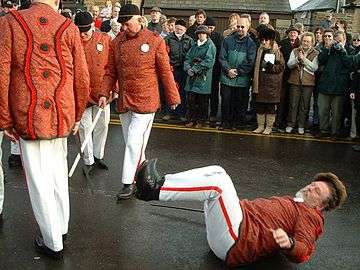Long Sword dance
The Long Sword dance is a hilt-and-point sword dance recorded mainly in Yorkshire, England. The dances are usually performed around Christmas time and were believed to derive from a rite performed to enable a fruitful harvest.

History
The Long Sword dance is related to the rapper sword dance of Northumbria, but the character is fundamentally different as it uses rigid metal or wooden swords, rather than the flexible spring steel rappers used by its northern relation.[1]
Although Long Sword dances are found scattered all over Yorkshire, there are particular concentrations of dances in East Cleveland, the northern part of the North York Moors and around Sheffield.[2] Cecil Sharp and other 20th Century folklorists formed that opinion that the dances originated from a religious or magical ceremony that was performed around Plough Monday to promote fertile soil:[3] later researchers have cast doubt on such findings.[4] They were banned under Oliver Cromwell, but revived when the monarchy was restored under Charles II.[5]
Long Sword dances vary in the way they are performed, with some being slow and militaristic,[6] such as the Grenoside or performed with pace and speed like Handsworth dances from near Sheffield. Others have different features including variations of numbers of dancers and distinctive movements.[7]
Unlike many traditional dances in England, which are mainly performed by revival teams, Long Sword dances are often still performed by their own village teams, such as Grenoside Sword Dancers,[1] the Goathland Plough Stots[6] and Flamborough Sword Dancers.[8] These teams generally maintain the traditions of their dances, such as traditional performances on Boxing Day or Plough Monday.[9]
The International Sword Spectacular took place in Whitby, England in May 2004 and was held again in York in May 2008.[10]
- Long sword dancing
- Boxing Day 2005 - The Grenoside Sword Dance Captain holds aloft the sword lock before placing it around his neck
 Boxing Day 2004 - The Grenoside Sword Dance Captain is ritually "beheaded" as the dancers withdraw their swords sharply from around his neck
Boxing Day 2004 - The Grenoside Sword Dance Captain is ritually "beheaded" as the dancers withdraw their swords sharply from around his neck The final figure in the Sword Dance
The final figure in the Sword Dance
References
- "Sheffield sword dancers perform at Belgium festival". The Sheffield Star. 3 May 2017. Retrieved 5 January 2018.
- Sharp 1913, p. 9.
- Sharp 1913, p. 10.
- Ronald Hutton, The Triumph of the Mooon Oxford (1999) Chapter 7
- "Kirkburton Rapiers celebrate 40 years of Yorkshire long sword dancing". Yorkshire Life. 10 April 2014. Retrieved 5 January 2018.
- Bradtke, Elaine (7 January 2009). "Elaine Bradtke's guide to five lesser-known English folk dances". The Guardian. Retrieved 5 January 2018.
- Sharp 1913, pp. 9–14.
- "Sword dancers ready for Boxing Day tradition". Bridlington Free Press. 12 December 2017. Retrieved 5 January 2018.
- "Continuity, Conflict and Change: A Contextual and Comparative Study of Three South Yorkshire Longsword Dance Teams" (PDF). whiterose.ac.uk. pp. 331–338. Retrieved 5 January 2018.
- Hutchinson, Charles (16 May 2008). "Sword play". York Press. Retrieved 5 January 2018.
Sources
- Sharp, Cecil (1913). The sword dances of Northern England; part 3 (1 ed.). London: Novello. OCLC 801635200.
External links
- International Sword Spectacular 2004
- World Millennium Sword Spectacular
- The Sword Dance Union
- Grenoside Sword Dancers
- Newcastle Kingsmen
- Kirkburton Rapier
- Spen Valley Longsword
- Bishop Gundulf's Morris
- Lingdale Primrose – archive photos, press cuttings and other material
- Star Of Swords Sword Dance